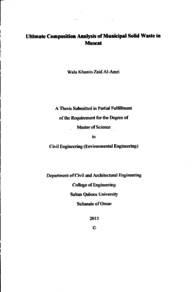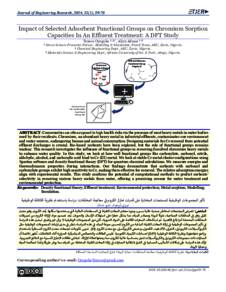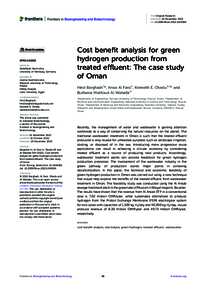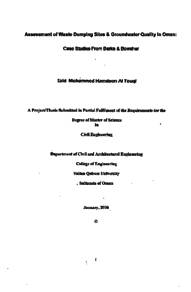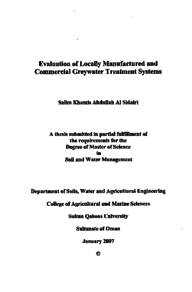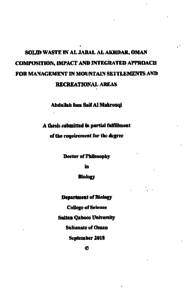Document
Ultimate composition analysis of municipal solid waste in Muscat
Publisher
Sultan Qaboos University
Gregorian
2015
Language
English
English abstract
Municipal solid wastes are daily generated refuses from different sources that contains various composition that may affect public health as well as the environment. The aim of this study is to analyze the ultimate composition of municipal solid waste in Muscat, Sultanate of Oman. The study was conducted on 22 samples that were collected from the 15thcampaign of waste characterization at Al Amerat landfill in February 2015. Different size fractions of less than 8 mm up to 100 mm were used as well as 11 waste categories samples.
At the same time two different sets of leachate samples were used in this study, the first set was collected on March 2015 and the second set was collected on April 2015. Each set consists of two type of leachate, a relatively fresh leachate collected from the pond inlet and the older leachate samples were collected from the leachate pond.
The analysis of this study was done for physical characteristics of MSW (composition of waste, moisture content and density), as well as the approximate analysis of chemical characteristics(moisture content, volatile content, loss on ignition and total oxides) and the Ultimate Analysis (CHNS/O analysis, chemical content, heavy metals, heating value and energy content).
The leachate characteristics were also analyzed (pH, electrical conductivity, turbidity, total solid, bacteriological analysis, biochemical oxygen demand (BOD), chemical oxygen demand (COD), and total organic carbon (TOC) and Ammonia Nitrogen).
The main composition of the waste generated were 24% plastic wraps, 14% cardboard and 8% food which accounted 46% of total characterized sample weight. More than 40% of disposed materials at Al Amerat landfill consisted of biodegradable organic components. These materials are being landfilled without any form of treatment. Based on the results obtained, this study is recommending a 'Waste to Energy' program in the near future as the waste of the landfill has an energy content of more than 22,000 kJ/kg. The content of the waste was presented in a chemical formula with sulfur C215 H395 0120 N2 S and without sulfur C125 H230 070 N.
Member of
Resource URL
Arabic abstract
النفايات البلدية الصلبة التي يتم توليدها يوميا هي عبارة عن مخلفات أو بقايا مواد من مصادر مختلفة تتكون من العديد من المركبات التي تؤثر على الصحة العامة وكذلك البيئة الطبيعية. تهدف هذه الدراسة إلى تحليل التركيب النهائي للنفايات البلدية الصلبة في مسقط، وقد أجريت الدراسة على ۲۲ عينة تم جمعها من الحملة الخامسة عشرة لتوصيف نفايات مردم العامرات الهندسي خلال فبراير ۲۰15م. ولقد تم فرز النفايات حسب الحجم إلى أقل من 8 ملم وحتی ۱۰۰ ملم بالإضافة إلى ۱۱ فئة من مختلف أنواع النفايات. كما تم تحليل العصارة الناتجة من المردم من خلال نوعين من العينات وتحليلها خلال شهري مارس وأبريل من العام ۲۰۱۵م. وقد أجريت التحاليل في هذه الدراسة عن الخصائص الفيزيائية للنفايات الصلبة البلدية (تكوين النفايات، ومحتوى الرطوبة والكثافة)، فضلا عن التحليل التقريبي للخصائص الكيميائية (محتوى الرطوبة، ومحتوى المواد المتطايرة، والفاقد من التسخين ومجموع الأكاسيد) والتحليل النهائي (تحليل الكربون، والهيدروحين، والاكسجين، والنيتروجين، والكبريت ، والمحتوى الكيميائي، والمعادن الثقيلة والقيمة الحرارية، ومحتوى الطاقة). تم أيضا تحليل عصارة المردم ( درجة الحموضة، والتوصيل الكهربائي، ودرجة التعكر، ومجموع المواد الصلبة، والتحليل البكتريولوجي، و الطلب على الأكسجين الحيوي، والطلب على الأكسجين الكيميائي ، والكربون العضوي الكلي والأمونيا).
توصلت هذه الدراسة إلى أن التراكيب الرئيسية للنفايات المتولدة يتألف من حوالي ٪۲۶ من البلاستيك، 14٪ من الورق المقوی و ۸٪ من المخلفات الغذائية والتي تمثل ما مجموعه نحو 46 % من نسبة المواد الصلبة الملقاه في المردم. أكثر من ٪40 من المواد المتخلص منها في مردم النفايات بالعامرات تتكون من النفايات العضوية القابلة للتحلل. هذه المواد لا تزال تملا المردم دون أي شكل من أشكال المعالجة. واستنادا إلى النتائج التي تم التوصل إليها، فإن هذه الدراسة توصي بأخذ تقنيات "تحويل النفايات إلى طاقة " بعين الإعتبار في المستقبل القريب لما أظهرته الدراسة من إمكانيات معقولة لمحتوى الطاقة المتولدة من النفايات الصلبة . وقد توصلت الدراسة إلى أن التركيب الكيميائي للمخلفات في مسقط هو C215 H : 9s O120 N2S مع الكبريت و Caus Hs9s O120 N2 بدون الكبريت.
توصلت هذه الدراسة إلى أن التراكيب الرئيسية للنفايات المتولدة يتألف من حوالي ٪۲۶ من البلاستيك، 14٪ من الورق المقوی و ۸٪ من المخلفات الغذائية والتي تمثل ما مجموعه نحو 46 % من نسبة المواد الصلبة الملقاه في المردم. أكثر من ٪40 من المواد المتخلص منها في مردم النفايات بالعامرات تتكون من النفايات العضوية القابلة للتحلل. هذه المواد لا تزال تملا المردم دون أي شكل من أشكال المعالجة. واستنادا إلى النتائج التي تم التوصل إليها، فإن هذه الدراسة توصي بأخذ تقنيات "تحويل النفايات إلى طاقة " بعين الإعتبار في المستقبل القريب لما أظهرته الدراسة من إمكانيات معقولة لمحتوى الطاقة المتولدة من النفايات الصلبة . وقد توصلت الدراسة إلى أن التركيب الكيميائي للمخلفات في مسقط هو C215 H : 9s O120 N2S مع الكبريت و Caus Hs9s O120 N2 بدون الكبريت.
Category
Theses and Dissertations

